18.8 Applications of Electrostatics The study of electrostatics has proven useful in many areas. This module covers just a few of the many applications of electrostatics. The Van de Graaff Generator Van de Graaff generators (or Van de Graaffs) are not only spectacular devices used to demonstrate high voltage due to static electricity-they are also used for serious research. The first was built by Robert Van de Graaff in 1931 (based on original suggestions by Lord Kelvin) for use in nuclear physics research. Figure 18.38 shows a schematic of a large research version. Van de Graaffs utilize both smooth and pointed surfaces, and conductors and insulators to generate large static charges and, hence, large voltages. A very large excess charge can be deposited on the sphere, because it moves quickly to the outer surface. Practical limits arise because the large electric fields polarize and eventually ionize surrounding materials, creating free charges that neutralize excess charge or allow it to escape. Nevertheless, voltages of 15 million volts are well within practical limits. Conductor lon source To experimental area Flexible nonconductive belt Insulator Ground Figure 18.38 Schematic of Van de Graaff generator. A battery (A) supplies excess positive charge to a pointed conductor, the points of which spray the charge onto a moving insulating belt near the bottom. The pointed conductor (B) on top in the large sphere picks up the charge. (The induced electric field at the points is so large that it removes the charge from the belt.) This can be done because the charge does not remain inside the conducting sphere but moves to its outside surface. An ion source inside the sphere produces positive ions, which are accelerated away from the positive sphere to high velocities. B.
18.8 Applications of Electrostatics The study of electrostatics has proven useful in many areas. This module covers just a few of the many applications of electrostatics. The Van de Graaff Generator Van de Graaff generators (or Van de Graaffs) are not only spectacular devices used to demonstrate high voltage due to static electricity-they are also used for serious research. The first was built by Robert Van de Graaff in 1931 (based on original suggestions by Lord Kelvin) for use in nuclear physics research. Figure 18.38 shows a schematic of a large research version. Van de Graaffs utilize both smooth and pointed surfaces, and conductors and insulators to generate large static charges and, hence, large voltages. A very large excess charge can be deposited on the sphere, because it moves quickly to the outer surface. Practical limits arise because the large electric fields polarize and eventually ionize surrounding materials, creating free charges that neutralize excess charge or allow it to escape. Nevertheless, voltages of 15 million volts are well within practical limits. Conductor lon source To experimental area Flexible nonconductive belt Insulator Ground Figure 18.38 Schematic of Van de Graaff generator. A battery (A) supplies excess positive charge to a pointed conductor, the points of which spray the charge onto a moving insulating belt near the bottom. The pointed conductor (B) on top in the large sphere picks up the charge. (The induced electric field at the points is so large that it removes the charge from the belt.) This can be done because the charge does not remain inside the conducting sphere but moves to its outside surface. An ion source inside the sphere produces positive ions, which are accelerated away from the positive sphere to high velocities. B.
College Physics
10th Edition
ISBN:9781285737027
Author:Raymond A. Serway, Chris Vuille
Publisher:Raymond A. Serway, Chris Vuille
Chapter16: Electrical Energy And Capacitance
Section16.1: Electric Potential Energy And Electric Potential
Problem 16.2QQ: If a negatively charged particle is placed at rest in an electric potential field that increases in...
Related questions
Question
Applications of Electrostatics
• Name several real-world applications of the study of electrostatics.

Transcribed Image Text:18.8 Applications of Electrostatics
The study of electrostatics has proven useful in many areas. This module covers just a few of the many applications of
electrostatics.
The Van de Graaff Generator
Van de Graaff generators (or Van de Graaffs) are not only spectacular devices used to demonstrate high voltage due to static
electricity-they are also used for serious research. The first was built by Robert Van de Graaff in 1931 (based on original
suggestions by Lord Kelvin) for use in nuclear physics research. Figure 18.38 shows a schematic of a large research version.
Van de Graaffs utilize both smooth and pointed surfaces, and conductors and insulators to generate large static charges and,
hence, large voltages.
A very large excess charge can be deposited on the sphere, because it moves quickly to the outer surface. Practical limits arise
because the large electric fields polarize and eventually ionize surrounding materials, creating free charges that neutralize
excess charge or allow it to escape. Nevertheless, voltages of 15 million volts are well within practical limits.

Transcribed Image Text:Conductor
lon source
To
experimental
area
Flexible
nonconductive
belt
Insulator
Ground
Figure 18.38 Schematic of Van de Graaff generator. A battery (A) supplies excess positive charge to a pointed conductor, the points of which spray the
charge onto a moving insulating belt near the bottom. The pointed conductor (B) on top in the large sphere picks up the charge. (The induced electric
field at the points is so large that it removes the charge from the belt.) This can be done because the charge does not remain inside the conducting
sphere but moves to its outside surface. An ion source inside the sphere produces positive ions, which are accelerated away from the positive sphere
to high velocities.
B.
Expert Solution
This question has been solved!
Explore an expertly crafted, step-by-step solution for a thorough understanding of key concepts.
This is a popular solution!
Trending now
This is a popular solution!
Step by step
Solved in 2 steps

Knowledge Booster
Learn more about
Need a deep-dive on the concept behind this application? Look no further. Learn more about this topic, physics and related others by exploring similar questions and additional content below.Recommended textbooks for you

College Physics
Physics
ISBN:
9781285737027
Author:
Raymond A. Serway, Chris Vuille
Publisher:
Cengage Learning

College Physics
Physics
ISBN:
9781285737027
Author:
Raymond A. Serway, Chris Vuille
Publisher:
Cengage Learning